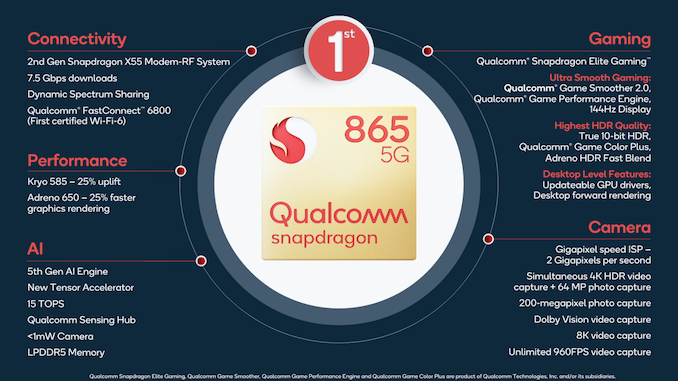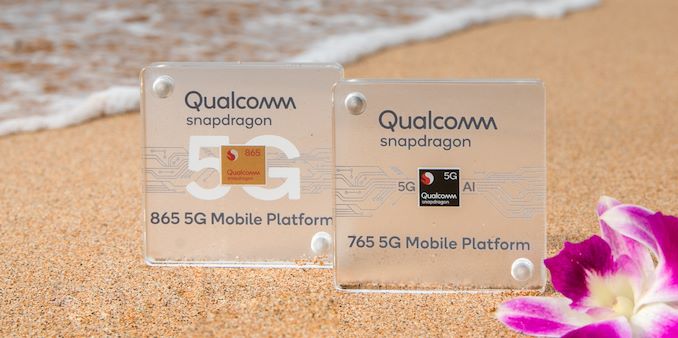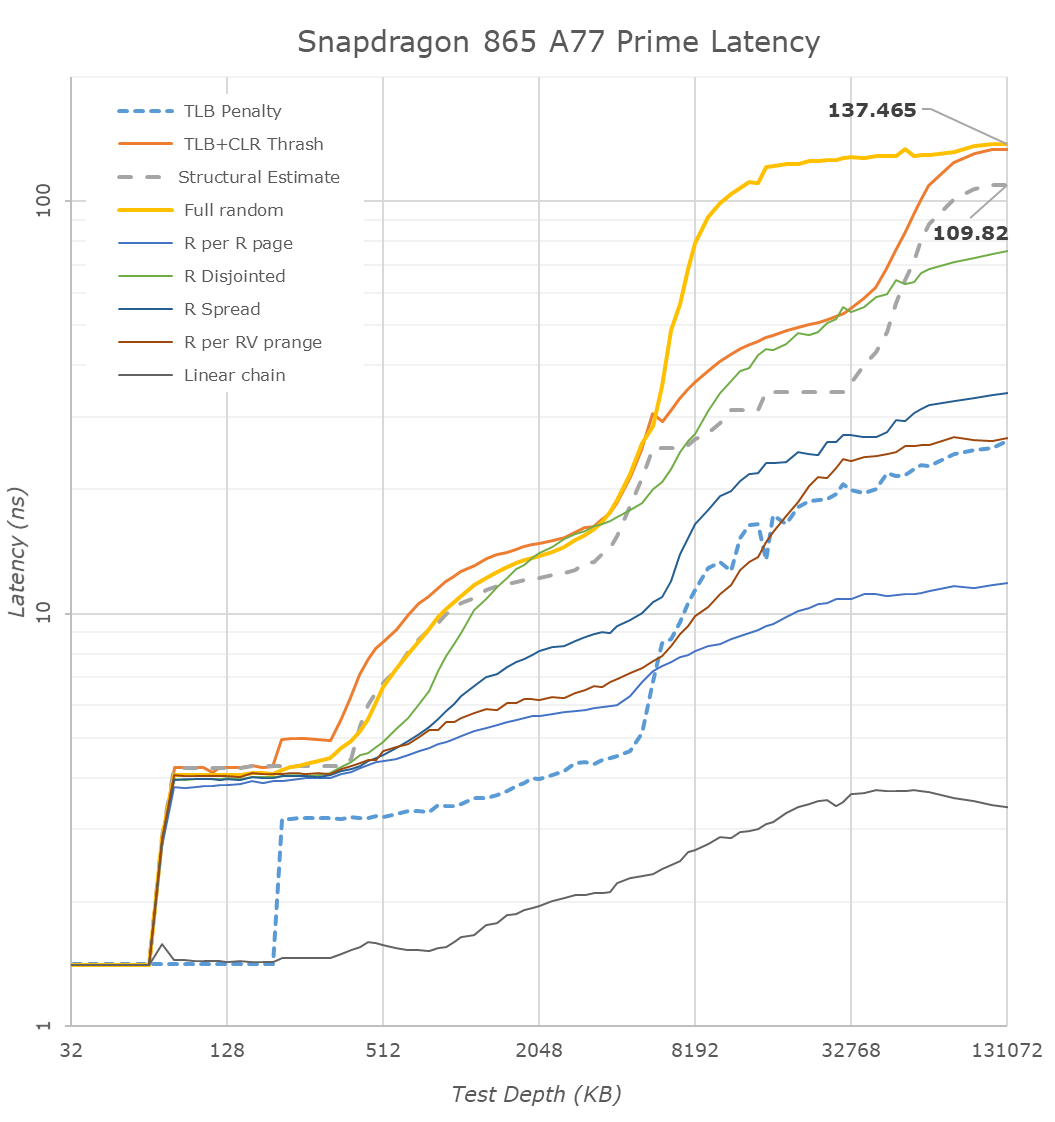The Snapdragon 865 Performance Preview: Setting the Stage for Flagship Android 2020
by Andrei Frumusanu on December 16, 2019 7:30 AM EST- Posted in
- Mobile
- Qualcomm
- Smartphones
- 5G
- Cortex A77
- Snapdragon 865

Earlier this month we had the pleasure to attend Qualcomm’s Maui launch event of the new Snapdragon 865 and 765 mobile platforms. The new chipsets promise to bring a lot of new upgrades in terms of performance and features, and undoubtedly will be the silicon upon which the vast majority of 2020 flagship devices will base their designs on. We’ve covered the new improvements and changes of the new chipset in our dedicated launch article, so be sure to read that piece if you’re not yet familiar with the Snapdragon 865.
As has seemingly become a tradition with Qualcomm, following the launch event we’ve been given the opportunity to have some hands-on time with the company’s reference devices, and had the chance to run the phones through our benchmark suite. The QRD865 is a reference phone made by Qualcomm and integrates the new flagship chip. The device offers insight into what we should be expecting from commercial devices in 2020, and today’s piece particularly focuses on the performance improvements of the new generation.
- Qualcomm Announces Snapdragon 865 and 765(G): 5G For All in 2020, All The Details
- Qualcomm Windows on Snapdragon: New 7c & 8c SoCs for sub-$800 Laptops
- Quick Bytes: Qualcomm’s Dynamic Spectrum Sharing Demo with 5G and 4G
- Quick Bytes: Qualcomm’s Prediction of 1.4 Billion 5G Smartphones by 2022
- Qualcomm Snapdragon Tech Summit Live Blog: Day One
- Qualcomm Snapdragon Tech Summit Live Blog Day Two: All About Mobile
- Qualcomm Snapdragon Tech Summit Day 3 Live Blog: ACPC and XR
A quick recap of the Snapdragon 865 if you haven’t read the more thorough examination of the changes:
| Qualcomm Snapdragon Flagship SoCs 2019-2020 | |||
| SoC |
Snapdragon 865 |
Snapdragon 855 | |
| CPU | 1x Cortex A77 @ 2.84GHz 1x512KB pL2 3x Cortex A77 @ 2.42GHz 3x256KB pL2 4x Cortex A55 @ 1.80GHz 4x128KB pL2 4MB sL3 @ ?MHz |
1x Kryo 485 Gold (A76 derivative) @ 2.84GHz 1x512KB pL2 3x Kryo 485 Gold (A76 derivative) @ 2.42GHz 3x256KB pL2 4x Kryo 485 Silver (A55 derivative) @ 1.80GHz 4x128KB pL2 2MB sL3 @ 1612MHz |
|
| GPU | Adreno 650 @ 587 MHz +25% perf +50% ALUs +50% pixel/clock +0% texels/clock |
Adreno 640 @ 585 MHz |
|
| DSP / NPU | Hexagon 698 15 TOPS AI (Total CPU+GPU+HVX+Tensor) |
Hexagon 690 7 TOPS AI (Total CPU+GPU+HVX+Tensor) |
|
| Memory Controller |
4x 16-bit CH @ 2133MHz LPDDR4X / 33.4GB/s or @ 2750MHz LPDDR5 / 44.0GB/s 3MB system level cache |
4x 16-bit CH @ 1866MHz LPDDR4X 29.9GB/s 3MB system level cache |
|
| ISP/Camera | Dual 14-bit Spectra 480 ISP 1x 200MP 64MP ZSL or 2x 25MP ZSL 4K video & 64MP burst capture |
Dual 14-bit Spectra 380 ISP 1x 192MP 1x 48MP ZSL or 2x 22MP ZSL |
|
| Encode/ Decode |
8K30 / 4K120 10-bit H.265 Dolby Vision, HDR10+, HDR10, HLG 720p960 infinite recording |
4K60 10-bit H.265 HDR10, HDR10+, HLG 720p480 |
|
| Integrated Modem | none (Paired with external X55 only) (LTE Category 24/22) DL = 2500 Mbps 7x20MHz CA, 1024-QAM UL = 316 Mbps 3x20MHz CA, 256-QAM (5G NR Sub-6 + mmWave) DL = 7000 Mbps UL = 3000 Mbps |
Snapdragon X24 LTE (Category 20) DL = 2000Mbps 7x20MHz CA, 256-QAM, 4x4 UL = 316Mbps 3x20MHz CA, 256-QAM |
|
| Mfc. Process | TSMC 7nm (N7P) |
TSMC 7nm (N7) |
|
The Snapdragon 865 is a successor to the Snapdragon 855 last year, and thus represents Qualcomm’s latest flagship chipset offering the newest IP and technologies. On the CPU side, Qualcomm has integrated Arm’s newest Cortex-A77 CPU cores, replacing the A76-based IP from last year. This year Qualcomm has decided against requesting any microarchitectural changes to the IP, so unlike the semi-custom Kryo 485 / A76-based CPUs which had some differing aspects to the design, the new A77 in the Snapdragon 865 represents the default IP configuration that Arm offers.
Clock frequencies and core cache configurations haven’t changed this year – there’s still a single “Prime” A77 CPU core with 512KB cache running at a higher 2.84GHz and three “Performance” or “Gold” cores with reduced 256KB caches at a lower 2.42GHz. The four little cores remain A55s, and also the same cache configuration as well as the 1.8GHz clock. The L3 cache of the CPU cluster has been doubled from 2 to 4MB. In general, Qualcomm’s advertised 25% performance uplift on the CPU side solely comes from the IPC increases of the new A77 cores.
The GPU this year features an updates Adreno 650 design which increases ALU and pixel rendering units by 50%. The end-result in terms of performance is a promised 25% upgrade – it’s likely that the company is running the new block at a lower frequency than what we’ve seen on the Snapdragon 855, although we won’t be able to confirm this until we have access to commercial devices early next year.
A big performance upgrade on the new chip is the quadrupling of the processing power of the new Tensor cores in the Hexagon 698. Qualcomm advertises 15 TOPS throughput for all computing blocks on the SoC and we estimate that the new Tensor cores roughly represent 10 TOPS out of that figure.
In general, the Snapdragon 865 promises to be a very versatile chip and comes with a lot of new improvements – particularly 5G connectivity and new camera capabilities are promised to be the key features of the new SoC. Today’s focus lies solely on the performance of the chip, so let’s move on to our first test results and analysis.
New Memory Controllers & LPDDR5: A Big Improvement
One of the larger changes in the SoC this generation was the integration of a new hybrid LPDDR5 and LPDDR4X memory controller. On the QRD865 device we’ve tested the chip was naturally equipped with the new LP5 standard. Qualcomm was actually downplaying the importance of LP5 itself: the new standard does bring higher memory speeds providing better bandwidth, however latency should be the same, and power efficiency benefits, while there, shouldn’t be overplayed. Nevertheless, Qualcomm did claim they focused more on improving their memory controllers, and this year we’re finally seeing the new chip address some of the weaknesses exhibited by the past two generations; memory latency.
We had criticised Qualcomm’s Snapdragon 845 and 855 for having quite bad memory latency – ever since the company had introduced their system level cache architecture to the designs, this aspect of the memory subsystem had seen some rather mediocre characteristics. There’s been a lot of arguments in regards to how much this actually affected performance, with Qualcomm themselves naturally downplaying the differences. Arm generally notes a 1% performance difference for each 5ns of latency to DRAM, if the differences are big, it can sum up to a noticeable difference.
Looking at the new Snapdragon 865, the first thing that pops up when comparing the two latency charts is the doubled L3 cache of the new chip. It’s to be noted that it does look that there’s still some sort of logical partitioning going on and 512KB of the cache may be dedicated to the little cores, as random-access latencies start going up at 1.5MB for the S855 and 3.5MB for the S865.
Further down in the deeper memory regions, we’re seeing some very big changes in latency. Qualcomm has been able to shave off around 35ns in the full random-access test, and we’re estimating that the structural latency of the chip now falls in at ~109ns – a 20ns improvements over its predecessor. While it’s a very good improvements in itself, it’s still a slightly behind the designs of HiSilicon, Apple and Samsung. So, while Qualcomm still is the last of the bunch in regards to its memory subsystem, it’s no longer trailing behind by such a large margin. Keep in mind the results of the Kirin 990 here as we go into more detailed analysis of memory-intensive workloads in SPEC on the next page.
Furthermore, what’s very interesting about Qualcomm’s results in the DRAM region is the behaviour of the TLB+CLR Trash test. This test is always hitting the same cache-line within a page across different, forcing a cache line replacement. The oddity here is that the Snapdragon 865 here behaves very differently to the 855, with the results showcasing a separate “step” in the results between 4MB and ~32MB. This result is more of an artefact of the test only hitting a single cache line per page rather than the chip actually having some sort of 32MB hidden cache. My theory is that Qualcomm has done some sort of optimisation to the cache-line replacement policy at the memory controller level, and instead the test hitting DRAM, it’s actually residing at on the SLC cache. It’s a very interesting result and so far, it’s the first and only chipset to exhibit such behaviour. If it’s indeed the SLC, the latency would fall in at around 25-35ns, with the non-uniform latency likely being a result of the four cache slices dedicated to the four memory controllers.
Overall, it looks like Qualcomm has made rather big changes to the memory subsystem this year, and we’re looking forward to see the impact on performance.













178 Comments
View All Comments
Alistair - Tuesday, December 17, 2019 - link
go into your BIOS and run your Intel computer in dual core mode, 2.6Ghz, and come back and tell me it is fast...id4andrei - Wednesday, December 18, 2019 - link
The software running on these platforms in not identical. Some of it depends on CPU extensions that are not equivalent between platforms. A dual core 2.6 Ghz intel chip will run slower Win10 than an ipad pro would run ios. But you could find a Linux distribution and some oss apps that would run very fast on that 2.6 Ghz dual core intel.Quantumz0d - Tuesday, December 17, 2019 - link
LOL. You won the most stupid comment here congrats."Android fanatics" so you are an Apple sheep I guess.
Sandybridge OCed to 4GHz+ still keeps up with a 1080Ti without any issues. That shows how Intel milked and Ryzen caught up due to monopoly. And you are crippling an x86 LGA socket processor to 2.6GHz Dual core and compare with an iPad Pro ? In what usecase ? What is the ultimate goal here ? Lets disable all Lightning and Thunder cores and run 1 Lightning then (You cant do it anyways since Apple is the overlord here). What the actual fuck lmao. Also magically slapping in more A13 cores means x86 Intel and AMD are dead, haha you think this is making a sandwich at home ? I thinm you never heard of Sparc or IBM Power go and read snd get your mind blown on threads but do not compare that to x86 or Apple A series Alien technology please. An iOS cannot even process zip file extraction nor a config file for a VPN. That alone breaks the whole A series King to ashes as its not used in a real computer at all. A psuedo Filesystem and fake filemanager app doesn't make it a proper OS. Unfortunately Android is also following same.retarded path thanks to Apple disease at Google emulating by the abomination called Scoped Storage disaster.
Let me tell you a secret the laptop you used all are garbage and they are cut down bottom barrel silicon from the failed Desktop chips and so on. The age of rPGA Intel is fucked (Last XM is 4930MX, a true binned Mobile Chip like K) Thanks to BGA greed of Apple infecting Intel for max profits and people to be subverted to use BGA / soldered trash throttling thin and light crappy planned obsolescence HW.
Let us run a Cinebench on your beloved processor then or lets run a POVray or a H264 Transcoding. Well how about we game a PUBG and stream it at 1080P highest quality.
This is the reason why I see x86 vs ARM talk irrelevant and often AT articles are quoted to prove the IPC and all SPEC scores but completely ignore scalability, compatibility, legacy code, HW market etc, when the compute workloads / OS / Software Code / HW which are entirely different world. Like comparing a Jet fighter to a Jet ski.
Alistair - Tuesday, December 17, 2019 - link
Nice rant. Might want to read my comment before going off like a crazy person? I said I only buy Android phones... right there in the first sentence.Before you blindly state how amazing x86 CPUs are, as I said, run your Intel CPU in dual core mode at 2.6 Ghz and compare how slow it is vs. the A13 Apple chip that is also 2 power cores at a low frequency. That's what IPC is. I can't understand why people get so triggered about saying Apple has the highest IPC in the industry. It's a simple fact and I just have to assume you don't know what you are talking about. Andrei's articles always seem to attract the most illiterate part of the internet.
markol4 - Monday, December 23, 2019 - link
A13 IPC is superior to Intel or AMD but Apple CPU core is huge in terms of transistors budget. IIRC in A11 times Apple CPU core had at least 2 times more transistors than x86 CPU core. Considering that there is no surprise that Apple has a higher IPC.imaheadcase - Tuesday, December 17, 2019 - link
They might as well just make a chart and put "BUZZWORDS" on it at this point.That is what is so silly about current state of smart phones. So much they can cram into one..but rarely do they do..or if they do its crippled by terrible software.
Google is already facing so much criticism of Google Photos bullshit, months in and they just say "we are aware of it". lol
imaheadcase - Tuesday, December 17, 2019 - link
I don't think i'll ever understand how Google can take a product, that works great, then release a dozen updates with release notes that "fixes bugs" and completely borks it for users. I mean what is the fucking incentive. Oh and because everything google is so entwined with other software, for whatever reason, it fucks up other things. So now you try to figure out what software is the original culprit or is it the others now. This shit never ends with google.Nicon0s - Wednesday, December 18, 2019 - link
Do you know what's amusing?The vast majority of people reading this article don't really understand what those numbers showed by the SPEC actually mean, what they represent for the functionality of the phone. Most only copy paste things form the article that they like, especially the parts where it's mentioned that the Qualcomm chips are "years" behind. So it doesn't matter how the phone runs and how fast it can execute real world tasks.
One thing I don't understand is if I would buy a Galaxy S11+ instead of an iphone 11 Pro Max what will I be missing in terms of performance? What specific advantage would the A13 SOC give me because "it's years ahead" in performance?
cha0z_ - Friday, December 27, 2019 - link
My second hand iphone 6s runs super smooth, including in heavy beautiful games - no fps drops or performance issues. Doing so on Galaxy s6 (the available competition model from the same year) is not possible.This is where the powerful SOC shines - years down the road where the phone stays relevant and a pleasure to use. Ofc you will not have to worry about that with your S11+ as samsung support their phones fully for only two years (3rd is security updates only). Really they drop the phone as full/serious support even before the first year drops - this is what happened with my note 9, no attention at all - just quick security updates and no interest beyond that. After all - they put the capable engineers to work only towards the new upcoming phones. Apple support FULLY their phones for 5-6 years + they released this summer a security update for iphone 5 and 4s - 2011 and 2012 model. Any android phone from those years receiving a security update?
Also you can play full PC civilization 6 game on the iphone. No android port and not only because piracy, but because on later turns/bigger maps the android SOCs will choke and the wait time between turns - unbearable. I can list you also a lot more games exclusive to ios, a lot because of performance. Dead cells for example, keeping in touch with the devs - the mobile port dev team (it's outsourced) struggles BIG TIME with performance on android thus massively delaying it.
tranceazure1814 - Tuesday, December 17, 2019 - link
So the main point that I want to know,is it worth upgrading to a Snapdragon 865 over a Snapdragon 855 and while we on the subject does the mi mix 3 5g has less LTE bands than the standard snapdragon 845 mi mix 3?